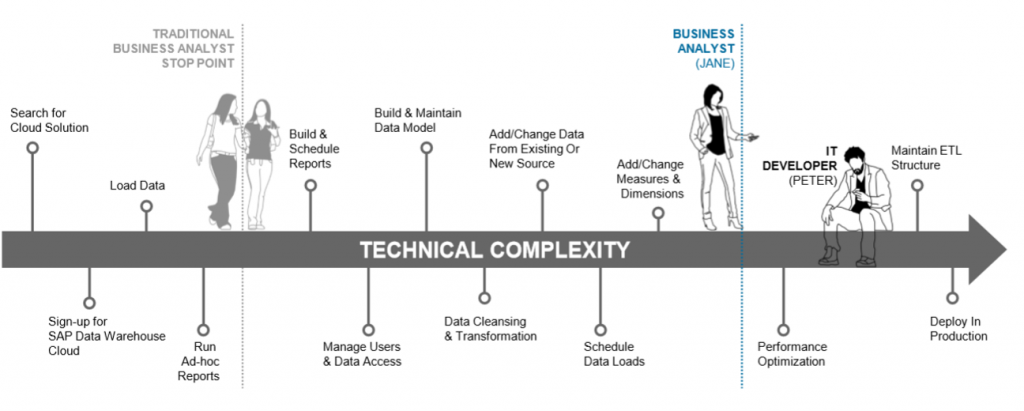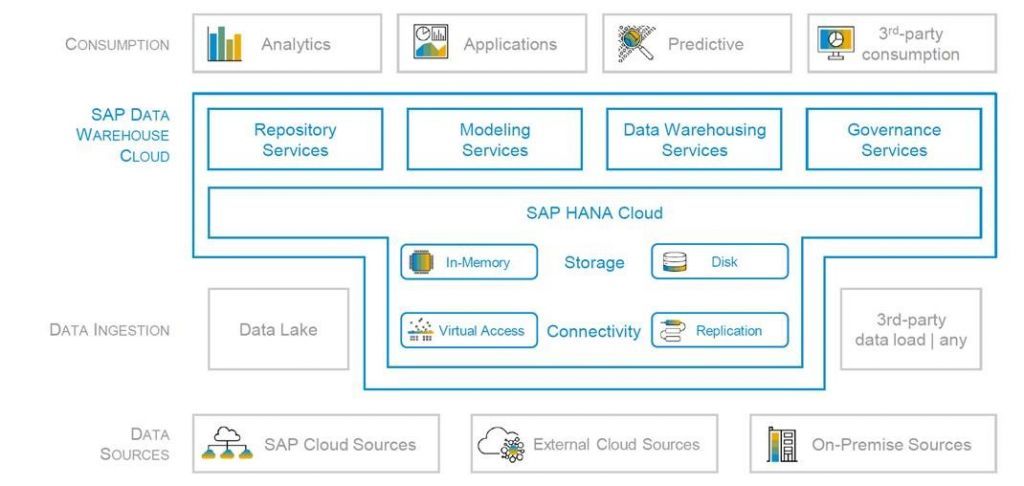SAP Data Warehouse Cloud: Bridging an Important Gap in the SAP Analytics Landscape

Author – Tim Allan, Senior Analytics Consultant , NTT DATA Business Solutions UK
What is Data Warehouse Cloud (DWC)?
Things have been moving in a fairly predictable way over the last few years. My ERP can be in the cloud, my HR can be in the cloud, my CRM can be in the cloud, my Analytics can be in the cloud. Wait, where did I leave my Data Warehouse?
Data Warehouse Cloud is SAP’s next move into the cloud space, and perhaps their most plainly descriptive product name since ‘Dashboards’. It provides a space for agile data modelling, with the ability to control both data access and the allocation of memory for different user groups, and of course makes full use of the power of an underlying HANA database. It’s a cloud-native Enterprise Data Warehouse (EDW) built from scratch, using some of the best qualities of SAP’s well-established EDW options, Native HANA and BW/4HANA, but offering something a little different to either. In terms of its modelling capabilities, it’s most easily broken down into three key areas, which will be familiar to those with a history in Data Warehousing:
• The Data Layer: where I provision and model my persisted or virtualised data. Here I can load my data from SAP Cloud or On-Premise sources, from the expected variety of 3rd Party sources or from flat files. I can model my data using standard HANA tables, Calculation Views or Data Store Objects (one for the BW fans out there), and create dataflows to describe the movement and transformation of data between these objects. I can still access and model my On-Premise data virtually if I don’t want to load it into the cloud.
• The Semantic Layer: where I define my facts, dimensions, KPIs and hierarchies – introducing friendly business terms I know my reporting and analytics users will be familiar with.
• The Business Catalog: this to me is key for a data warehouse (and the reason that BW remains the best of breed in the on-premise EDW space) – it’s where I ensure that all my objects are consistent and reusable, and I can also version or document them as I wish. No-one will be using two different definitions of Product on my watch.
Who is it for?
When you show SAP Analytics Cloud (SAC) to a room full of people (particularly its Smart Discovery/Insight and Smart Predict capabilities) you’ll usually see an instant reaction as they realise it will give them the insight and agility they’ve been looking for. I believe that you’ll see a similar reaction to DWC, just for a smaller group of people in that room – Line of business (LOB) users who take a keen interest in data and more specifically how to access, define, transform, model and then schedule its availability.

Traditionally the modelling and transformation of data has been controlled centrally by IT, and while SAP has made moves into this sort of functionality before (for example, with Workspaces in BW/4HANA), this is their first targeted move into the self-service market for an EDW.
IT will still play their part however, as someone still needs to control system governance, the security model and HANA memory allocation across different groups of LOB users. If there is more complicated data integration to do or there are business-wide scenarios required then IT will still likely need to do the underlying work to give the LOB users a foundation to build upon.
This is definitely an important move in-line with the increasing trend towards self-service in the BI and Analytics market, but only time will tell how much of this work LOB users will have the capacity and interest to take on within individual businesses once DWC is rolled out into offices. I would expect to see different levels of take-up in different businesses, depending on their structure and culture: the overall progress of their BI journey, how centralised their front-end Analytics is, and how data-savvy those LOB users are.
What value can it add?
Well, firstly there’s the obvious selling points of any cloud application – SAP will be constantly patching and adding functionality at a pace that will be familiar to adopters of SAC, while reducing the total cost of ownership for the business. It will also benefit from elasticity even more than operational cloud applications – want to add another huge dollop of data to your warehouse? No problem!
But for me, the single strongest selling point of DWC is bridging a gap in the current SAP Analytics portfolio: for where SAC isn’t powerful enough for loading and transforming data, but where there isn’t a strong enough requirement (or simply a lack of enthusiasm) for BW/4HANA.
DWC has been designed with integration with SAC in mind, and as such will enable an organisation to have a complete end-to-end, easily-apopted Analytics architecture in the cloud. Couple this with the promise of standard content models for S/4HANA and the suite of SAP Cloud Applications and you have a clear and instant driver for value to any business who has already invested in any part of the SAP suite. The standard content also gives it an advantage over the Native HANA capabilities of SAP Cloud Platform (SCP) which offers a blank slate with which to build upon.
Once we get to grips with DWC we’ll be able to see more accurately how it compares to its wider-industry competitors, such as Snowflake and Amazon Redshift, and gauge whether this value can also be extended to non-SAP customers. While it’s still early, SAP’s outline of the capabilities of DWC’s services and integrations certainly points towards it being a competitive prospect in this space.

How does DWC fit into the existing SAP EDW landscape?
Let’s get this one out there up front: if you have a business with very complex business rules and scenarios or large data volumes that have led you to BW/4HANA, you’ll still be led towards BW/4HANA. But that’s not where DWC is being initially positioned – at present it’s more of a user-friendly gateway between SAC and other SAP applications and databases. In fact, one of its main use-cases will be in a hybrid scenario with BW/4HANA (this is SAP’s stated current strategy), letting the more powerful data warehouse do the grunt work and instead taking on the more agile part of the requirement. There are also future plans to allow the migration of BW/4HANA models into DWC, though at present gaps in functionality mean that there will be work to do for SAP to get this up and running.

But the key to the success of DWC with existing SAP customers in a hard-fought marketplace remains in the delivery of standard content – if it can allow an organisation with S/4HANA and no BW/4HANA a way out of cottage industry Analytics, then it can provide instant value. While operational Analytics can remain in S/4HANA, DWC gives the implementation of a platform for strategic analytics a lower barrier for entry.
What’s the roadmap?
Future plans for DWC include further integration with both BW/4HANA and Big Data technologies, as well as further content by both functional area and industry. SAP’s long-term goal is to bring functional parity between BW/4HANA and DWC, which again will take significant further work but is the obvious direction in an industry steadily advancing into the Cloud.
You can find more details about DWC here, and watch this space to find out more as it evolves.
DWC is currently starting a Beta program, with involvement from SAP partners and customers. It’s due to go into General Availability at the end of 2019, so definitely one for the Christmas list for any data-starved LOB users!
(Images taken from latest SAP DWC presentations)